published by "Organised Sound" Vol.8 / 2, Cambridge
University Press, January 2004
Sound
- Time - Space - Movement
The
Space-soundInstallations of the Artist-couple <sabine schäfer // joachim
krebs>
by <sabine
schäfer // joachim krebs>
Abstract, Introduction, afterword and translation:
Ralf Nuhn and John Dack
Lansdown Centre for Electronic Arts, Middlesex University London
Abstract
This article describes the theories and practices of the German installation
artists and composers Sabine Schäfer and Joachim Krebs. Much of their
work concerns site-specific sound installations involving the articulation
of time and space. Their principal work methods and materials are described.
In addition, they have formulated a typology of five installation types which
they describe using their own installations as examples. Each installation
type responds to a particular set of aesthetic and practical challenges both
for the artists and the visitors. These are discussed and illustrated in the
article. The typology extends beyond the specific work of these artists and
can be applied to installations in general thus providing a framework for
critical analysis. Furthermore, the translators have discussed the issues
regarding the specialised vocabulary of the artists and the rendering of such
language into English.
Introduction
The term 'installation' includes many different types of artwork. Some
works are site-specific and derive their meaning from being placed in a specific
location with historical, social or environmental associations. Others occupy
a space within a gallery or public venue and function in a manner independent
of the space itself. In addition to the physical dimensions, structure and
position of the installation, the relationship between the aural and visual
components is usually of fundamental importance. Both senses can provide mutual
support or contradict each other in a series of constantly shifting and occasionally
unsettling interactions.
In installations where sound is essential to the work, the sensibilities of
musicians can assume a significant role. Working with sound is not, of course,
the sole prerogative of musicians. Nevertheless, in general musicians are
acutely aware both of the potential of real-world sounds as well as the acoustic
properties of spaces. (This is particularly true of practitioners of electroacoustic
music).
In recent works of the artist-couple <sabine schäfer // joachim krebs>
spaces are 'sonified' by means of carefully constructed installations which
are placed with meticulous care within the location. The physical arrangement
of the loudspeakers becomes in effect a living 'body' or 'organism' creating
a form of mediation between the sound types, their actual movements and the
installation situated in the space. The static, physical structure is thereby
'energised' by means of computer control via specially designed software and
the visitor experiences processes of revealing and exploring spaces by sound.
In the following article <sabine schäfer // joachim krebs> suggest
a typology of installation artworks. Each type exemplifies a particular aspect
of their practice and reveals a preoccupation for creating the most appropriate
installation for the specific space and how it will be experienced by visitors.
The value of such an installation-typology results not only from the way it
explains the artist-couple's practice, but also from the more generally applicable
criteria it offers other artists. Many installations can be situated within
one of the suggested five types. Texts which comment upon and clarify artworks
often have a particular authority if written by the artists themselves. Some
artists, of course, are reluctant to explain their practice believing the
work to be autonomous and capable of speaking for itself. However, when artists
are willing to discuss their work, readers have access to the kind of private
self-reflection that can be so illuminating.
In translating the article we encountered problems common to all attempts
at rendering foreign texts into English. These concern not only issues of
selecting the correct English equivalent but also the necessity of communicating
accurately the writer's thoughts. For example, should a translator endeavour
to retain the 'feel' of the original text? Such a decision might demand the
retention of phrases which appear ungainly in English but nonetheless communicate
something of the text's meaning. Many translators of Adorno, for example,
seem to adopt this strategy. Sub-clauses are interposed between an introductory
phrase and the main clause with its verbs at the end of the sentence. The
English translation thus remains defiantly 'Germanic' in structure but, far
from making the text opaque, the accurate placing of stress is preserved and
meaning often enhanced. Alternatively, a 'free' approach can be adopted and
the immediate comprehension for the reader - both specialist and non-specialist
- is given priority. However, clarity can lapse into the simplistic and intelligibility
suffers. Our solution is, inevitably perhaps, a compromise.
We have previously translated an article by <sabine schäfer // joachim
krebs> describing the work 'Sonic Lines n' Rooms' (SAN Diffusion, Sept.
2000). In this article the artist-couple outlined their approach to the particular
problems of this site-specific work (see also: Mitteilungen 33 of DEGEM, July,
1999 and Positionen 37, Berlin, November 1998). It was apparent that two terms
required particular attention. The issue stemmed from the way two specific
installation-types functioned. On the one hand, a 'sound-body' could be situated
within a space and visitors are encouraged to approach it from various directions.
Or, a 'sound-body' could be constructed such that people can move around within
its confines. In the former case the visitor is external to the object, in
the latter s/he is embraced by it. The German word describing an installation
in which the visitor moves around in order to explore the interactions between
the space and the sounds is 'begehbar'. This is the third installation-type,
the 'enterable Space-soundBody' (begehbarer RaumklangKörper). In our
first translation 'begehbar' was translated as 'accessible' but in the context
of the present translation this word seemed imprecise. 'Accessible' suggests
that the installation comprising the sound-body and the space in which it
is situated is available to the visitor if s/he chooses to participate. In
the present translation the term 'enterable' has been substituted for 'accessible'.
Even though it is a relatively uncommon word, it conveys more accurately the
necessity for the visitor to actually enter the installation and actively
explore.
By contrast, the German term 'umgehbar', used for the second installation-type,
indicates that the visitor can walk around rather than within the installation.
The term we use is 'circumambulatory' as in 'circumambulatory Space-soundBody'
(umgehbarer RaumklangKörper). This word is almost certain to be more
familiar than 'enterable' and, as anyone with even a modicum of Latin will
realise, it means that the installation can be walked around and approached
from any direction (unless deliberately restricted by the artist). Naturally,
it would have been gratifying to use words retaining the parallel construction
of the German 'umgehbar/begehbar'. Circumambulatory/intra-ambulatory was considered
(albeit briefly) but rejected as too unwieldy. In neither case is there any
compulsion for the visitor to walk across the space in a straight line or
around the installation in any direction - clockwise or anti-clockwise. Nor
is movement meant to be uninterrupted. The visitor should, indeed must, make
use of the complete space available to experience the animating effects of
the sounds emanating from what appears to be a living 'sound-body'. The organic
metaphor of a "sound-body" is deliberate.
The term 'Space-soundBody' (RaumklangKörper) - which must be differentiated
from 'Space-soundObject' (RaumklangObjekt) - has been retained in English.
Consequently, we were persuaded to translate its separate components or 'Glieder'
as 'limbs' to maintain the organic metaphor rather than use the more neutral
word 'parts'.
Lastly, we should not overlook the playful aspect of artists' language. In
the description of their work 'TopophonicPlateaux' <sabine schäfer
// joachim krebs> use the term 'Klangfarbgrundierungen'. The play between
the words 'Farbe' (colour) and 'Grundierung' (a painter's 'priming coat')
is lost unless the term 'Klangfarbe' - literally 'sound-' or tone-colour'
- is understood. However, to express the concept of a first step which is
needed before the final application of other sounds, our translation as 'sound-colour
priming coats' communicates (we hope) the idea accurately (though unfortunately
not with the lightness of the original text). Such are the problems of translation
and we can only hope we have captured the essence of what these artists wish
to express.
SOUND
- TIME - SPACE - MOVEMENT
by
<sabine schäfer // joachim krebs>
I. Time Becomes Space - Space Becomes Time
All modern perception theories are based on the fact that human perceptions
of time and space are interdependent. A distance covered by a person - or
a sound - in space is initially perceived as a temporal phenomenon, allowing
a person to develop a subjective notion of space and time by measurement and
comparison.
Thus, movement in space becomes time. Time periods become spatial distances.
The sensation of time is realised by the sensation of space and vice-versa.
Space becomes an experience of time due to the movement of the sound event.
Time accordingly becomes an open, imaginary process of generating illusory
space. Rooms which are open, unbounded, liberated from the linearly directed
flow of time serve as three dimensional canvases for constantly changing processes
generating transitions.
Between TemporalSpaces and SpatialTimes, there are manifold variations of
IntermediateZones with their IntermediateSpaces and their IntermediateTimes.
All this leads to a dissolution of the real performing space, where time itself
stages a linear-dramatic, goal-directed idea (of space?).
Instead, the cyclic, non-linear consciousness of time releases the desire
to become "immersed" in psychological inner space, to fade out physical
outer space with its real time and its thinking spaces (which are predetermined
in their substance) by concentrating on the perception of what might seem
on the surface, unprepossessing sound events based on elementary-harmonic,
simple sound-materials and -transformations, to set free your vision, or to
put it better, your hearing, so that you may experience the present - from
one moment to another - as a possibility of transitions, of freely flowing
conditions.
In the Space-soundInstallations of the artist-couple <sabine schäfer//joachim
krebs> specific soundspaces are created, which incorporate the movement
of sounds in space as an intrinsic part of the composition. The composition's
individual sound strata are, so to speak, transferred into the exterior space
and by means of a loudspeaker matrix - which is installed in the space and
controlled by computer with software exclusively developed for the artist-couple
- moved and placed respectively in space. Hence, the free distribution of
sound sources in space and the compositional sound space extended by the real
movements of sounds, are specific to this space-sound art. This compositional
sound space - primarily defined as time-based art - thus also approaches spatial
art. This is comparable with the medium of film/video, in which the image
formerly represented statically can, by its movement, be experienced as time-based
art.
The experience of space-sound events which are moved in the architechtonic
space is not only meant to give an intensive spatial experience, it also becomes
an experience of shaping time acoustically and artistically.
Individual sound locations and sound sources are, by their movement, turned
into a quasi organically proliferating sound line, which - itself interconnected
to build an artificial matrix of time and space - offers acoustic images of
SpaceTimeNets floating freely in 'non-time'.
Space and time themselves are turned into interactive qualities of perception,
constantly fluctuating between the 'real' and the 'unreal' sensation of space
and time.
II. Artificial Soundscapes between Pure Realism
and Pure Abstraction
In almost all works of the artist-couple from 1995 onwards in the area
of Space-soundInstallations, amorphous animal/natural voices and sounds respectively,
as well as heterogeneous everyday noises from human surroundings and habitats
form the most important sonic source material, though there is neither language,
singing nor instrumentally or synthetically generated sound material! Below
are examples of the most essential aspects of the artist-couple's working
methods.
An initial, important stage in composition is the intensive study of each
individual found and selected noise and sound. The most important question
at this stage is: which naturally existing and which potential, artificial
consistency is held by each individual sound in the initially inaudible, molecular
interior of its microstructure? Therefore, noises and sounds are recorded
with a digital sampler. Delving into the smallest molecular region, the sampler
is able to put at the disposal of the sound artist single particles of the
inner structure of this noise-sound matter for artistic development. With
these 'abstract machines' - to quote a concept of the French philosophers
Deleuze/Guattari - we carried out, as it were, what we called an 'EndoSonoScopy'
of the individual sound materials to take single sound tests (so-called samples
or fragment-patterns) from the organic sound web. Here the samplers serve
as audio-microscopes with a complex of interfaces, which enter the organic
sound structure in order to record and split their variations into molecules.
These are then artistically transformed in a further operation.
Previously imperceptible inner-polyphonies and harmonic sound-fields of unfolding
inner resonance spaces now become audible. What occurs is, as it were, a revealing
and exteriorising of the inner intensities of the respective sounds.
All of this was 'preparatory' work carried out according to a quasi scientific
approach of the observer and researcher; only now does it become interesting
for the actual artistic composition process. The next stage is to produce
an artificial consistency by means of the most varied artificial transformations
of the previously carefully selected sound materials.
The artificial consistency formation as a symbiotically-fluorescing 'animal-nature-noise-
becoming' of sound succeeds here all the more when the animal, nature, noise
becomes something 'other': pure line, pure colour, pure rhythm, pure movement,
pure figure… pure condition.
Furthermore, so-called 'artificial sound milieux' are formed in a quasi acoustic
amalgamation process. That is, a temporarily existing, specific mixture of
sound substances and particles creates a symbiotic diversity of dynamically
driven SoundEnergyStructures by means of self-impelled, proliferating self-intensifying
loops - always starting from the middle (mi/middle lieu/place).
Another essential aspect of this microscopy of sound and noise is the dissolving
of each particular sound's semantic meaning. Whereas, at its original pitch,
the sound was identifiable as something 'definite', for example a frog or
a toad, it moves further away from its original semantic character the stronger
the augmentation degree is. One could also say that the subjective substantial
matter of the original sound transforms into a desubjectivised expressive
matter of transformed fragment patterns. Intermediary stages during changing
consistencies are formed, between concrete and abstract, natural and artificial
and so on.
Thus, the artificial soundscape appears as an ensemble of desubjectivised
expressive matter in the artistically layered sound system of the horizontal,
rhythmic-melodic sound figure and the vertical, resonant-harmonic sound-space.
III.
The five most important
types of Space-soundInstallations
Over several years different types of Space-soundInstallations
have crystallised and developed - due to, amongst other things, different
performance situations. The five most important types will be illustrated
below:
-
The
Space-soundObject
-
The
circumambulatory Space-soundBody
-
The
enterable Space-soundBody
-
Space-within-Space
-
Concert
Space-soundBody
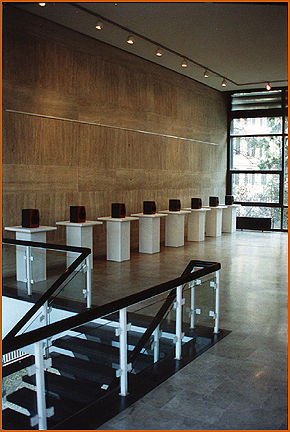 The characteristic aspect of the Space-soundObject is a two-dimensional arrangement
of the loudspeakers, which radiate sound in one direction. This results in an
optimal reception zone in which the visitor can approach and move away from
the object. Therefore, Space-soundObjects are usually positioned against a wall.
The characteristic aspect of the Space-soundObject is a two-dimensional arrangement
of the loudspeakers, which radiate sound in one direction. This results in an
optimal reception zone in which the visitor can approach and move away from
the object. Therefore, Space-soundObjects are usually positioned against a wall.
Figure 1 shows the Space-soundObject 'Sonic Lines', commissioned by Nuova Consonanza,
Rome in 1998. The 2-dimensional loudspeaker configuration is placed in the shape
of an 8-limbed line alongside a marble wall in the foyer of the Goethe Institute
in Rome. The loudspeaker configuration of the Space-soundObject is inspired
by the specific dimensions of the architectural space. Clearly perceptible 'line-sounds'
(forming rolling-ball motifs) are counterpointed by internally fluctuating water
sounds which represent the liquid, unstable condition of the 8-channel Space-soundComposition.
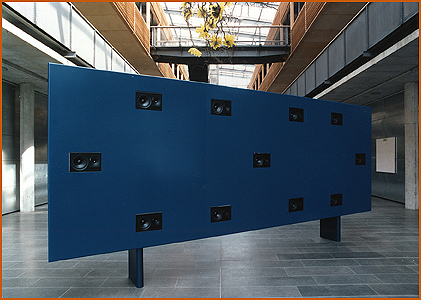 Figure 2 shows the Space-soundObject 'Hörbild' ('Audible Picture'). The
eleven-limbed speaker ensemble is set into a monochrome, blue sound-wall, resulting
in an object resembling an image on a panel. The speaker matrix of the 'Hörbild'
forms the shape of an infinity symbol.
Figure 2 shows the Space-soundObject 'Hörbild' ('Audible Picture'). The
eleven-limbed speaker ensemble is set into a monochrome, blue sound-wall, resulting
in an object resembling an image on a panel. The speaker matrix of the 'Hörbild'
forms the shape of an infinity symbol.
However, the sound does not only move along the path of the infinite bow, but
the speaker tableau becomes instead a territory, a construction for sounds on
which they spread, compress, evaporate and become solid again. The Space-soundObject
was commissioned by the Siemens Arts Program, Munich and was presented for the
first time at the Berliner Festwochen 1995 with the 11-channel Space-soundComposition
'Tableau I-III'. Further works were produced in 1997 for the first exhibition
of the Sender Freies Berlin (SFB) sound gallery and for the MusikTriennale Cologne
1997, commissioned by the Studio Akustische Kunst of the WDR (Klaus Schöning).
2.
The circumambulatory Space-soundBody
The
circumambulatory Space-soundBody is a type of Space-soundInstallation the individual
exhibits of which have a three dimensional sculptural structure of loudspeakers
which can radiate sound in different directions and which is specifically developed
for the particular architectural space. The distribution of the sound sources
in the space is arranged in such a way that both a horizontal and a vertical
linear loudspeaker body are formed, around which one can walk and through which
the individual sound strata sound with specifically developed types of movements.
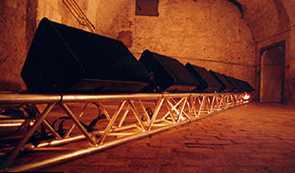 The
dimensions, and measurements of the individual loudspeaker-body depend on the
size of the performance space. As required, an object is developed for the loudspeaker
ensemble on which the loudspeakers are installed, as shown in figures 3 and
4.
The
dimensions, and measurements of the individual loudspeaker-body depend on the
size of the performance space. As required, an object is developed for the loudspeaker
ensemble on which the loudspeakers are installed, as shown in figures 3 and
4.
As the loudspeakers can radiate
in different directions and the loudspeaker ensemble is free-standing in the
space, the visitor can - by contrast with the Space-soundObject - perceive the
sound from different directions, the term 'circumambulatory' primarily refers
to the three-dimensional reception mode of the variable listening perspectives,
which are of equal quality throughout the entire space.
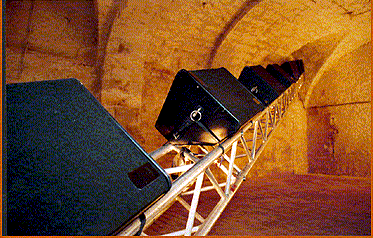 The
two examples illustrated here from the project series 'Sonic Lines n'Rooms'
represent an 8-limbed 'diagonal-horizontal' (Fig. 3) as well as an 8-limbed
'diagonal-vertical' (Fig. 4), circumambulatory Space-soundBody. The loudspeakers
are installed on steel crossbeams - each approximately 10 metres long - running
across the space. The figures show two of the four rooms of the vaulted cellars
of the Fürstlich Fürstenbergischen Hofbibliothek, for which the artist-couple
created a four-part Space-soundInstallation, as a commissioned piece for the
Donaueschinger Musiktage 1999.
The
two examples illustrated here from the project series 'Sonic Lines n'Rooms'
represent an 8-limbed 'diagonal-horizontal' (Fig. 3) as well as an 8-limbed
'diagonal-vertical' (Fig. 4), circumambulatory Space-soundBody. The loudspeakers
are installed on steel crossbeams - each approximately 10 metres long - running
across the space. The figures show two of the four rooms of the vaulted cellars
of the Fürstlich Fürstenbergischen Hofbibliothek, for which the artist-couple
created a four-part Space-soundInstallation, as a commissioned piece for the
Donaueschinger Musiktage 1999.
3.
The enterable Space-soundBody
The characteristic aspect
of the enterable Space-soundBody is the artistic-poetic treatment of the architectural
space. This is initiated by the artificial transformation of the raw material
'space at location' in order to open up the composed sound space by means of
the three-dimensional movement of the sounds and to facilitate specific states
in the acoustic becoming of architectural space.
The loudspeaker configuration
of an enterable Space-soundBody almost always includes the entire architectural
space. Generally, the speakers are positioned around and close to the walls
on different levels so the visitor - surrounded by the loudspeaker body - can
move freely within the space in order to experience very different auditory
perspectives.
The result is specific sound
spaces which are, among other things, shaped by the special characteristics
of the particular architecture. What takes place is in effect an 'acoustic topographing',
so that the dimensions of the imaginary auditory space and the real 'sounding'
sound space interweave and create a state of a specific space-time-continuum.
Through the aspect of
permanence these states preserve a certain authenticity of the 'real' in their
being-/staying-the-same and their constantly varied repetition.
For the recipient, real
space and moved sound space create specific synergies. The illusory space of
imagination develops (through the moved sound and one's own movement) within
the real space. What happens here is, so to speak, the cancellation of the 'real'
boundaries of space. Mental processes of changing location are initiated, which
- though imaginary and removed - are evoked by means of the shaped 'real' location
with its corresponding sound architecture.
A specific space emerges
in order that perception itself becomes specific.
 The
enterable Space-soundBodies shown in figures 5 and 6, represent another component
of the aforementioned 4-part Space-soundInstallation project 'Sonic Lines n'Rooms'.
The
enterable Space-soundBodies shown in figures 5 and 6, represent another component
of the aforementioned 4-part Space-soundInstallation project 'Sonic Lines n'Rooms'.
The four-part ensemble
as a whole - with a 32-channel Space-soundComposition for 4 x 8 loudspeakers
- is the artist-couple's first production for the project series of the same
name: 'Sonic Lines n'Rooms'. The series links the two different types of Space-soundInstallations
'circumambulatory Space-soundBody' and 'enterable Space-soundBody', which are
- depending on the project -applied individually or in combination.
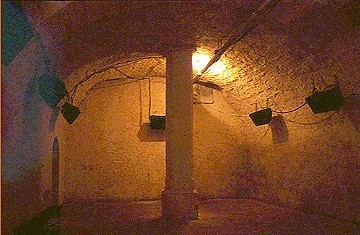 The
Space-soundBody 3 from 'Sonic Lines n'Rooms' was premiered in 2000 as a separate
enterable Space-soundBody at the 'KlangArt Buch', organised by the Akademie
der Künste Berlin. The concert performance of the Space-soundComposition
'Sonic Lines n'Rooms No.3' took place in the same year in Rotterdam, the Netherlands,
as part of the 'v_2' series of events 'Time-Based Space'.
The
Space-soundBody 3 from 'Sonic Lines n'Rooms' was premiered in 2000 as a separate
enterable Space-soundBody at the 'KlangArt Buch', organised by the Akademie
der Künste Berlin. The concert performance of the Space-soundComposition
'Sonic Lines n'Rooms No.3' took place in the same year in Rotterdam, the Netherlands,
as part of the 'v_2' series of events 'Time-Based Space'.
The Space-soundBody
4 from 'Sonic Lines n'Rooms' was first presented separately as part of the MIX.01
festival in Aarhus, Denmark in 2001 and the Space-soundComposition 'Sonic Lines
n'Rooms No.4' was premiered as part of the 10th Florida Electroacoustic Music
Festival in Gainesville, USA.
There are of course manifold
hybrid forms of the three described types of space-sound installations (Space-soundObject,
circumambulatory and enterable Space-soundBody) of which two possibilities are
introduced in the following text.
A.
Hybrid form of enterable and circumambulatory Space-soundBody with Space-soundObject.
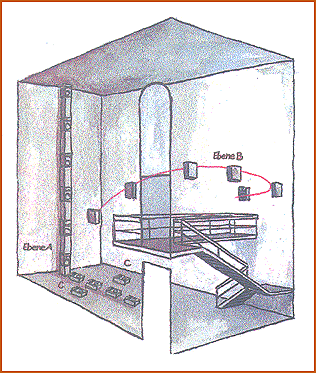 The
18-limbed Space-soundInstallation LOST (Fig 7) was staged with lighting and
was created for rooms with high ceilings and long reverberation periods. It
was first exhibited in 1992 in the light-well of the Badischer Kunstverein in
collaboration with the ZKM (Centre for Art and Media) in Karlsruhe, Germany.
The Space-soundInstallation is, above all, characterised by an approximately
7m high, 6-limbed loudspeaker column (Fig. 7, level A). Sound-masses plunge
down over this Space-soundObject and pull themselves up again in specific phases.
The
18-limbed Space-soundInstallation LOST (Fig 7) was staged with lighting and
was created for rooms with high ceilings and long reverberation periods. It
was first exhibited in 1992 in the light-well of the Badischer Kunstverein in
collaboration with the ZKM (Centre for Art and Media) in Karlsruhe, Germany.
The Space-soundInstallation is, above all, characterised by an approximately
7m high, 6-limbed loudspeaker column (Fig. 7, level A). Sound-masses plunge
down over this Space-soundObject and pull themselves up again in specific phases.
When entering the space through
the gallery in the upper floor the visitor is occasionally surrounded by a band
of sound that moves across an enterable Space-soundBody in the shape of a 6-limbed
loudspeaker-semicircle (Fig. 7, level B) and counterpoints the plunging sound
gestures. The circumambulatory Space-soundBody of level C, which is positioned
on the floor, mainly transmits fluctuating sound-colour priming coats ('Klangfarbgrundierungen')
and forms the sound tableau for the moved sounds of levels A and B.
B.
Hybrid form of enterable Space-soundBody with two circumambulatory Space-soundBodies
The 28-limbed Space-soundInstallation
'TopophonicPlateaux' (Fig. 8) which is staged with lighting consists of a 27-limbed
loudspeaker ensemble with a computer controlled concert grand piano. The 28-channel
Space-soundComposition was designed as a commission by the Donaueschinger Musiktage
1995, specifically for the Sternensaal concert hall in Donaueschingen, Germany.
This Space-soundBody is characterised by three installation components (see
Figure 8).
Component 1: An outer circle - consisting of 15 loudspeakers
- which starts at the right edge of the stage and ends at the left edge. The
loudspeakers are positioned at heights which successively ascend and then descend
again. The computer-controlled grand piano is located on the stage and thus,
as the 16th limb, it completes the space-enclosing loudspeaker circle. The grand
piano is triggered in real-time and is synchronised with the loudspeaker ensemble
via the computer.
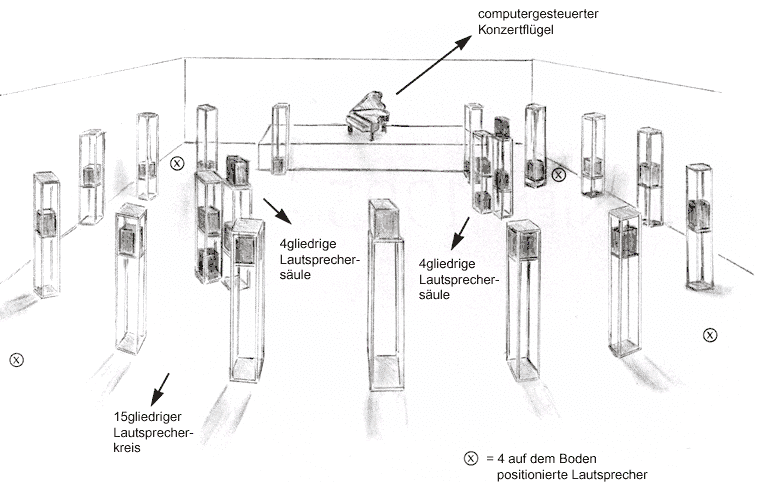 Component
2: Two columns - each consisting of 4 loudspeakers -, which
are positioned opposite each another in the inner space. The loudspeakers are
staggered at different heights and radiate in different directions. The two
loudspeaker-columns represent typical circumambulatory Space-soundBodies.
Component
2: Two columns - each consisting of 4 loudspeakers -, which
are positioned opposite each another in the inner space. The loudspeakers are
staggered at different heights and radiate in different directions. The two
loudspeaker-columns represent typical circumambulatory Space-soundBodies.
Component 3: Four loudspeakers, each of which
is positioned on the floor in the corners of the space. This group of loudspeakers
applies sound priming coats to the space and extends the loudspeaker circle
described under component 1 to a 20-limbed enterable Space-soundBody.
4.
Space-within-Space
This artistic concept is based
on a self-contained enterable Space-soundBody as 'space within (architectural)
space'. Consequently, the enterable Space-soundBody also becomes circumambulatory.
Through the combination
of the features of circumambulation and enterability, new qualities emerge which
establish an autonomous type of space-sound installation art. An example of
this is the Space-soundBody 'Klangzelt' (Soundtent) from the project series
'SonicRooms' (Fig. 9).
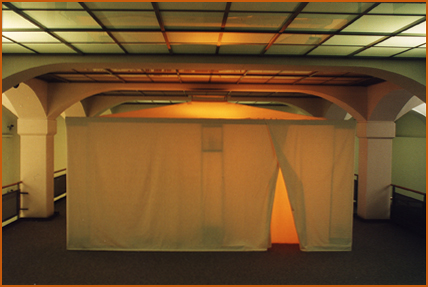 The
architechtonic dimensions of the space surrounding the Space-soundBody itself
is not explored acoustically - or to put it better 'sonified' - a process which
would in a sense render the room itself 'audible'. On the contrary, the installation
aims to eliminate as much as possible the real - visual as well as acoustical
- environment of the place where the enterable Space-soundBody is installed
- it is in fact a room within a room.
The
architechtonic dimensions of the space surrounding the Space-soundBody itself
is not explored acoustically - or to put it better 'sonified' - a process which
would in a sense render the room itself 'audible'. On the contrary, the installation
aims to eliminate as much as possible the real - visual as well as acoustical
- environment of the place where the enterable Space-soundBody is installed
- it is in fact a room within a room.
The interior of the Space-soundBody
entitled 'Klangzelt' ('Sound Tent') which is easily and effectively separated
from its surrounding space by a double fabric cover, leaves aside as much as
possible the visual aspect of the artistic design of space and time to intensify
the auditory reception of the artificially created virtual SoundSpaces.
As visual contact, a
crucial premise for orientation and localization, is prevented by thin draping
which is impervious to light but permeable to sound, it is possible to create
unreal-imaginary 'SensorySonicRooms', where actual moved sounds - perceived
only by the ear - can be experienced as an amorphous continuum of fleeting and
intangible conditions and acoustic atmospheres.
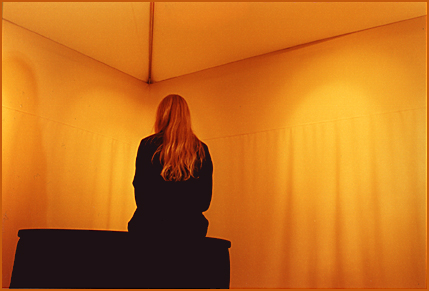 Paradoxically,
the artificial spatial qualities of sound are even enhanced by actual movement.
So, in order to experience the 'Klangzelt' adequately, you have to be there
'live', so that you may, for example, experience the difference between artificially
produced spatial qualities in the stereo image and the artificiality of psychological
"inner" perception of space, which is evoked by sounds tracing the
actual distance from loudspeaker to loudspeaker.
Paradoxically,
the artificial spatial qualities of sound are even enhanced by actual movement.
So, in order to experience the 'Klangzelt' adequately, you have to be there
'live', so that you may, for example, experience the difference between artificially
produced spatial qualities in the stereo image and the artificiality of psychological
"inner" perception of space, which is evoked by sounds tracing the
actual distance from loudspeaker to loudspeaker.
On the other hand, there
are artificial 'listening islands', which - similar to listening with headphones
- shut out the real space of the location by means of surrounding fabric covers,
so that the artificially produced spatial qualities of the spatial sound compositions
themselves will be more authentically perceived. Thus, at these islands it will
also be possible to achieve new listening experiences, which, among other things,
may lead to irritations of the 'normal' perceptions of space and time. In the
best cases the sound artwork evokes a free flowing SpaceTime experience between
an imaginary, psychological inner space and an 'actual' physical exterior space.
5.
The concert Space-soundBody
The concert Space-soundBody
represents a special kind of Space-soundInstallation. The most important criteria
of this type of Space-soundInstallation, which focuses solely on sound, are:
- Seating arrangement in
the performance space or concert hall (seated audience), resulting in the
definitive fixing of the four directions (front/back-left/right).
- Establishing the beginning
and end, and thus the total playing time, of the Space-soundComposition with
potential dramatic, linearly directed progression of the particular Space-soundComposition.
- Inclusion of a group of
instrumentalists as an element with equal rights to the Space-soundBody which
would otherwise consist only of loudspeakers.
- The concert loudspeaker-instrumental-body,
which is formed from loudspeakers and instrumentalists without any hierarchical
structure, generally surrounds the auditorium in a circular- or horseshoe-shape.
- The concert Space-soundBody
can be performed once in a concert or there can be several, consecutive performances
with the audience admitted at the beginning of each Space-soundComposition.
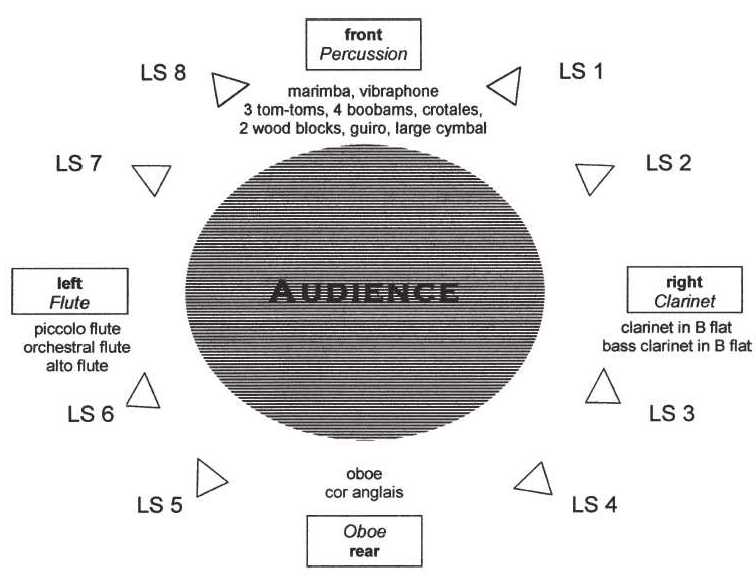 An
example is the Space-soundComposition 'TopoSonic Lines n'Rooms with Instruments'
(from Spring 2002) for a 12-limbed Space-soundBody, experienced in concert form,
with 8 loudspeakers and 4 instrumentalists (Percussion, Flute, Clarinet, Oboe).
An
example is the Space-soundComposition 'TopoSonic Lines n'Rooms with Instruments'
(from Spring 2002) for a 12-limbed Space-soundBody, experienced in concert form,
with 8 loudspeakers and 4 instrumentalists (Percussion, Flute, Clarinet, Oboe).
As a commission for
the AUDI-Culture Fund, this work has been tuned especially to the architecture
of the 'museum mobile' in Ingoldstadt, Germany. To suit the circular performance
space the loudspeakers and the instrumentalists, as shown in figure 10, were
grouped around the seated audience. By means of a corresponding instrumentation,
the instrumental part of the Space-soundComposition - in the same way as the
digital 8-channel tape - takes into account aspects of the space-sound movement,
resulting in a jointly 'acting' 12-limbed Space-soundBody.
Afterword
by Ralf Nuhn and John Dack
There is, of course, no compulsion
for artists ever to write about their practice. The histories of all the arts
have bodies of artworks with little or no corroborating evidence from those
who produced them. The theory is there, of course, but it is in the work and
we must disentangle it if we choose to analyse the work. However, since the
beginning of the last century and the institutionalisation of art there has
been a marked increase in texts written by practising artists who want to (or
feel obliged to) communicate the processes and underlying aesthetics of their
work. These might be texts written to emphasise a personal role in an art-form's
historical development - how many claim to have "invented" minimalism
or conceptual art, for example? Other authors are deliberately polemical such
as the young Boulez condemning as "useless" all those who failed to
recognise the necessity of serialism. Some, due to their role as teachers theorise
their practice within a pedagogical framework. For the theoretician or critic
all these writings provide valuable source material. Any form of self reflection
will almost certainly be appropriated by the academic community as an invaluable
research resource. It is an important way in which intellectual and aesthetic
discourses are created and sustained.
The sound installation
categories of <sabine schäfer // joachim krebs> described in the
article have been developed in the context of their own unique and original
practice. The absence of references to other artists indicates neither unfamiliarity
with the world of installation art, nor excessive introspection. As artists
who write about their work, their principal responsibility in this article is
to provide a coherent account of their own practice. Our role as translators
is to render the text accurately into English. However, due to our close contact
with the text and its authors, a secondary contextualising role has emerged.
Once a typology has been suggested it is available to everyone and can be used
with or without modifications to see if additional works can be included within
its categories. Some will be placed easily, others will resist inclusion. Both
results can be informative.
For example, the circumambulatory
Space-soundBody (category 2) is, broadly speaking, identical to sound sculptures
in general. Both terms refer to a three-dimensional object which can be walked
around and which emits sounds in different directions. One could, therefore,
place sound sculptures such as Stephan von Huene's Extended Schwitters (1987),
Trimpin's Liquid Percussion (1991) and Rolf Julius' Zwei Steine (1999) in this
category.
However, a clear distinction must be made. <sabine schäfer // joachim
krebs> emphasise that, due to the use of multi-channel recordings and individual
loudspeakers, the limbs of their Space-soundBody can emit different sounds.
This use of specific sounds from each limb would differentiate their works from
those cited (with the possible exception of Trimpin's Liquid Percussion). Nevertheless,
this does not contradict the initial classification. The consideration of the
specific role of sounds simply adds a further stage of refinement.
The first category - the Space-soundObject - can also be applied in this way.
In this two-dimensional arrangement, sound is emitted in one direction. Similar
examples are Takehisa Kosugi's Interspersions (1987) and Christina Kubisch's
The True and the False (1992). In both these works small speakers are mounted
on walls in plant-like configurations with the loudspeaker wires resembling
stalks. The distinct character of each work depends, naturally, on the specific
lighting, the position within the venue, the object's dimensions and (most importantly)
the sounds used by the artists. By including these works in the category of
Space-soundObject these individual features are not disregarded. The defining
aspect of the category is still the directionality of the speakers and the restriction
placed on the viewer's position. Additional examples can be suggested for the
other categories.
As the enterable Space-soundBody (category 3) has loudspeakers placed on the
walls of the space at various heights and positions, the visitor can move freely
in order to experience different auditory perspectives. An obvious historical
example would be the Philips Pavilion at the Brussel's World Fair in 1958. Though
in this case the movement of the sounds and the accompanying images were more
important than the "sonification" of the space as such. Other examples
are Bernhard Leitner's Ton-Raum (1984) and Ryoji Ikeda's A (2000). In the latter
case pure sinewaves and random noises were played within a narrow, purpose-built
corridor. The acoustic properties of this, albeit simple, space created different
listening experiences for the visitors. By walking at different speeds and by
changing direction along the corridor, the visitor could locate and pass through
distinct "sound areas".
Examples of the fourth category - Space-within-Space - are less common. This
type is based on a self-contained enterable Space-soundBody within the confines
of a gallery or a similar space. Consequently, such a Space-soundBody is also
circumambulatory. Once again, a potential example can be found in the works
of Bernhard Leitner. His Cylindre Sonore (1987) is a cylindrical space containing
24 loudspeakers. The sounds emitted are modified by natural factors such as
temperature, humidity and light. Our sole reservation regarding this work as
Space-within-Space is that is it situated in the open air rather than within
a venue with clear, architecturally defined acoustic characteristics. However,
the visitor to Leitner's space will experience both the sounds within the cylinder
and the sounds from outside.
Finally, the five criteria of the final category - the concert Space-soundBody
- conform to certain electroacoustic compositions where live instrumentalists
play in conjunction with recorded sounds. Even though an exploration of the
specific characteristics of the venue is not the principal objective, the practice
of sound diffusion is necessarily influenced by the venue's acoustics. No electroacoustic
composer would minimise the importance of this relationship which will, therefore,
have a decisive effect on the work as a whole. For example, Stockhausen's Kontakte
für elektronische Klänge, Klavier und Schlagzeug (1959-60) has a fixed
form and audience-instrumentalist relationship. In addition, the use of four
channel tape and the positioning of the loudspeakers and musicians will ensure
the intimate connection between the electronic sounds, the live sounds and the
concert space.
From these examples
it is clear that the typology suggested by <sabine schäfer // joachim
krebs> suits some works but needs modification for others. It must be stressed
that this particular typology was the end result of the work and practice of
<sabine schäfer // joachim krebs>. This is its unique quality and
its strength. Had it been developed by a theoretician, musicologist or art historian
the problematic nature of several of the aforementioned examples might well
have been addressed by creating sub-categories. However, in our initial attempts
the additional refinements usually resulted from considering the types of sounds
and how they were used by the artist. This specificity was clarified by an initial
categorisation. It is our opinion, therefore, that the origins of these five
categories in the works of <sabine schäfer // joachim krebs> does
not preclude their general applicability. The art of the sound installation
is still relatively new and this typology is an important addition to its theoretical
framework.
 The characteristic aspect of the Space-soundObject is a two-dimensional arrangement
of the loudspeakers, which radiate sound in one direction. This results in an
optimal reception zone in which the visitor can approach and move away from
the object. Therefore, Space-soundObjects are usually positioned against a wall.
The characteristic aspect of the Space-soundObject is a two-dimensional arrangement
of the loudspeakers, which radiate sound in one direction. This results in an
optimal reception zone in which the visitor can approach and move away from
the object. Therefore, Space-soundObjects are usually positioned against a wall.
 Figure 2 shows the Space-soundObject 'Hörbild' ('Audible Picture'). The
eleven-limbed speaker ensemble is set into a monochrome, blue sound-wall, resulting
in an object resembling an image on a panel. The speaker matrix of the 'Hörbild'
forms the shape of an infinity symbol.
Figure 2 shows the Space-soundObject 'Hörbild' ('Audible Picture'). The
eleven-limbed speaker ensemble is set into a monochrome, blue sound-wall, resulting
in an object resembling an image on a panel. The speaker matrix of the 'Hörbild'
forms the shape of an infinity symbol.  The
dimensions, and measurements of the individual loudspeaker-body depend on the
size of the performance space. As required, an object is developed for the loudspeaker
ensemble on which the loudspeakers are installed, as shown in figures 3 and
4.
The
dimensions, and measurements of the individual loudspeaker-body depend on the
size of the performance space. As required, an object is developed for the loudspeaker
ensemble on which the loudspeakers are installed, as shown in figures 3 and
4. The
two examples illustrated here from the project series 'Sonic Lines n'Rooms'
represent an 8-limbed 'diagonal-horizontal' (Fig. 3) as well as an 8-limbed
'diagonal-vertical' (Fig. 4), circumambulatory Space-soundBody. The loudspeakers
are installed on steel crossbeams - each approximately 10 metres long - running
across the space. The figures show two of the four rooms of the vaulted cellars
of the Fürstlich Fürstenbergischen Hofbibliothek, for which the artist-couple
created a four-part Space-soundInstallation, as a commissioned piece for the
Donaueschinger Musiktage 1999.
The
two examples illustrated here from the project series 'Sonic Lines n'Rooms'
represent an 8-limbed 'diagonal-horizontal' (Fig. 3) as well as an 8-limbed
'diagonal-vertical' (Fig. 4), circumambulatory Space-soundBody. The loudspeakers
are installed on steel crossbeams - each approximately 10 metres long - running
across the space. The figures show two of the four rooms of the vaulted cellars
of the Fürstlich Fürstenbergischen Hofbibliothek, for which the artist-couple
created a four-part Space-soundInstallation, as a commissioned piece for the
Donaueschinger Musiktage 1999.  The
enterable Space-soundBodies shown in figures 5 and 6, represent another component
of the aforementioned 4-part Space-soundInstallation project 'Sonic Lines n'Rooms'.
The
enterable Space-soundBodies shown in figures 5 and 6, represent another component
of the aforementioned 4-part Space-soundInstallation project 'Sonic Lines n'Rooms'. The
Space-soundBody 3 from 'Sonic Lines n'Rooms' was premiered in 2000 as a separate
enterable Space-soundBody at the 'KlangArt Buch', organised by the Akademie
der Künste Berlin. The concert performance of the Space-soundComposition
'Sonic Lines n'Rooms No.3' took place in the same year in Rotterdam, the Netherlands,
as part of the 'v_2' series of events 'Time-Based Space'.
The
Space-soundBody 3 from 'Sonic Lines n'Rooms' was premiered in 2000 as a separate
enterable Space-soundBody at the 'KlangArt Buch', organised by the Akademie
der Künste Berlin. The concert performance of the Space-soundComposition
'Sonic Lines n'Rooms No.3' took place in the same year in Rotterdam, the Netherlands,
as part of the 'v_2' series of events 'Time-Based Space'. The
18-limbed Space-soundInstallation LOST (Fig 7) was staged with lighting and
was created for rooms with high ceilings and long reverberation periods. It
was first exhibited in 1992 in the light-well of the Badischer Kunstverein in
collaboration with the ZKM (Centre for Art and Media) in Karlsruhe, Germany.
The Space-soundInstallation is, above all, characterised by an approximately
7m high, 6-limbed loudspeaker column (Fig. 7, level A). Sound-masses plunge
down over this Space-soundObject and pull themselves up again in specific phases.
The
18-limbed Space-soundInstallation LOST (Fig 7) was staged with lighting and
was created for rooms with high ceilings and long reverberation periods. It
was first exhibited in 1992 in the light-well of the Badischer Kunstverein in
collaboration with the ZKM (Centre for Art and Media) in Karlsruhe, Germany.
The Space-soundInstallation is, above all, characterised by an approximately
7m high, 6-limbed loudspeaker column (Fig. 7, level A). Sound-masses plunge
down over this Space-soundObject and pull themselves up again in specific phases. Component
2: Two columns - each consisting of 4 loudspeakers -, which
are positioned opposite each another in the inner space. The loudspeakers are
staggered at different heights and radiate in different directions. The two
loudspeaker-columns represent typical circumambulatory Space-soundBodies.
Component
2: Two columns - each consisting of 4 loudspeakers -, which
are positioned opposite each another in the inner space. The loudspeakers are
staggered at different heights and radiate in different directions. The two
loudspeaker-columns represent typical circumambulatory Space-soundBodies. The
architechtonic dimensions of the space surrounding the Space-soundBody itself
is not explored acoustically - or to put it better 'sonified' - a process which
would in a sense render the room itself 'audible'. On the contrary, the installation
aims to eliminate as much as possible the real - visual as well as acoustical
- environment of the place where the enterable Space-soundBody is installed
- it is in fact a room within a room.
The
architechtonic dimensions of the space surrounding the Space-soundBody itself
is not explored acoustically - or to put it better 'sonified' - a process which
would in a sense render the room itself 'audible'. On the contrary, the installation
aims to eliminate as much as possible the real - visual as well as acoustical
- environment of the place where the enterable Space-soundBody is installed
- it is in fact a room within a room.  Paradoxically,
the artificial spatial qualities of sound are even enhanced by actual movement.
So, in order to experience the 'Klangzelt' adequately, you have to be there
'live', so that you may, for example, experience the difference between artificially
produced spatial qualities in the stereo image and the artificiality of psychological
"inner" perception of space, which is evoked by sounds tracing the
actual distance from loudspeaker to loudspeaker.
Paradoxically,
the artificial spatial qualities of sound are even enhanced by actual movement.
So, in order to experience the 'Klangzelt' adequately, you have to be there
'live', so that you may, for example, experience the difference between artificially
produced spatial qualities in the stereo image and the artificiality of psychological
"inner" perception of space, which is evoked by sounds tracing the
actual distance from loudspeaker to loudspeaker. An
example is the Space-soundComposition 'TopoSonic Lines n'Rooms with Instruments'
(from Spring 2002) for a 12-limbed Space-soundBody, experienced in concert form,
with 8 loudspeakers and 4 instrumentalists (Percussion, Flute, Clarinet, Oboe).
An
example is the Space-soundComposition 'TopoSonic Lines n'Rooms with Instruments'
(from Spring 2002) for a 12-limbed Space-soundBody, experienced in concert form,
with 8 loudspeakers and 4 instrumentalists (Percussion, Flute, Clarinet, Oboe).